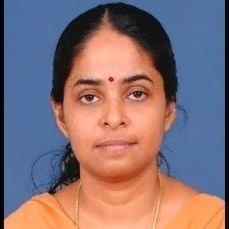
Thara Nair
Work place: Microwave Remote Sensing and Global Data Processing, SDAPSA, National Remote Sensing Centre, Balanagar, Hyderabad, India-500037
E-mail: thara_nair@nrsc.gov.in
Website:
Research Interests: Image Processing, Image Manipulation, Image Compression
Biography
Ms. Thara Nair did her M. Tech, Control Systems Engineering from College of Engineering, Trivandrum. She worked as Scientist in Vikram Sarabhai Space Centre, Indian Space Research Organization from 1997- 2010. She is currently working as Scientist in Data Processing Area in National Remote Sensing Centre, Indian Space Research Organization (ISRO). She is involved in High Performance Computing and algorithm development for image processing applications using GPGPU.
Author Articles
Generation of Analysis Ready Data for Indian Resourcesat Sensors and its Implementation in Cloud Platform
By Thara Nair Akshay Singh E.Venkateswarlu G.P.Swamy Vinod M Bothale B. Gopala Krishna
DOI: https://doi.org/10.5815/ijigsp.2019.06.02, Pub. Date: 8 Jun. 2019
The introduction of remote sensing techniques had lead us into a new race of advanced data processing applications. The analysis ready data is also a part of it which is generated at the producer end to facilitate its user to directly go on to the application part. This paper highlights the generation, processing and cloud applications of the Analysis Ready Data (ARD) using ISRO's Satellites Resourcesat-2 and Resourcesat-2A's LISS-3 sensor data. The proposed work includes use of terrain corrected data for generating Radiance, Top of Atmosphere (ToA) Reflectance, Normalized Difference Vegetation Index (NDVI), Enhanced Vegetation Index (EVI) and Time series analysis with pixel level Quality Assessment (QA) for all the generated data products. A graphical user interface has been developed for online ordering of data by the user. This paper also highlights the implementation of the developed application in cloud platform using the cloud computing model, Platform as a Service (PaaS).This facilitates the users to generate the ARD products from any device, facilitating a quick and all time available transmission rate for the customers.
[...] Read more.Scene based Non-uniformity Correction for Optical Remote Sensing Imagery
By Lolith Gopan E.Venkateswarlu Thara Nair G.P.Swamy B. Gopala Krishna
DOI: https://doi.org/10.5815/ijigsp.2017.12.06, Pub. Date: 8 Dec. 2017
In this work, we propose and evaluate different scene based methods for non-uniformity corrections for optical remote sensing data sets. These methods can be used to correct or refine the existing radiometric calibrations, thereby improving the image quality. The performance of each algorithm against different datasets are analyzed and a quantitative comparison of different quality parameters viz. entropy, correlation coefficient, signal to noise ratio, peak signal to noise ratio and structural similarity index are carried out to recommend the best method for each scene. For a given data set, the selected method depends on the severity, type of terrain it covered, etc.
[...] Read more.Estimation of NIIRS Incorporating an Automated Relative Edge Response Method
By Pranav V E.Venkateswarlu Thara Nair G.P.Swamy B. Gopala Krishna
DOI: https://doi.org/10.5815/ijigsp.2017.11.04, Pub. Date: 8 Nov. 2017
The quality of remote sensing satellite images are expressed in terms of ground sample distance, modular transfer function, signal to noise ratio and National Imagery Interpretability Rating Scale (NIIRS) by user community. The proposed system estimates NIIRS of an image, by incorporating a new automated method to calculate the Relative Edge Response (RER). The prominent edges which contribute the most for the estimation of RER are uniquely extracted with a combined application of certain filters and morphological operators. RER is calculated from both horizontal and vertical edges separately and the geometric mean is considered as the final result. Later applying the estimated RER along with other parameters, the system returns the NIIRS value of the input image. This work has proved the possible implementation of automated techniques to estimate the NIIRS from images and specifics in the metafile contents of imagery.
[...] Read more.Application of Texture Characteristics for Urban Feature Extraction from Optical Satellite Images
By D.Shanmukha Rao A.V.V. Prasad Thara Nair
DOI: https://doi.org/10.5815/ijigsp.2015.01.03, Pub. Date: 8 Dec. 2014
Quest of fool proof methods for extracting various urban features from high resolution satellite imagery with minimal human intervention has resulted in developing texture based algorithms. In view of the fact that the textural properties of images provide valuable information for discrimination purposes, it is appropriate to employ texture based algorithms for feature extraction. The Gray Level Co-occurrence Matrix (GLCM) method represents a highly efficient technique of extracting second order statistical texture features. The various urban features can be distinguished based on a set of features viz. energy, entropy, homogeneity etc. that characterize different aspects of the underlying texture. As a preliminary step, notable numbers of regions of interests of the urban feature and contrast locations are identified visually. After calculating Gray Level Co-occurrence matrices of these selected regions, the aforementioned texture features are computed. These features can be used to shape a high-dimensional feature vector to carry out content based retrieval. The insignificant features are eliminated to reduce the dimensionality of the feature vector by executing Principal Components Analysis (PCA). The selection of the discriminating features is also aided by the value of Jeffreys-Matusita (JM) distance which serves as a measure of class separability Feature identification is then carried out by computing these chosen feature vectors for every pixel of the entire image and comparing it with their corresponding mean values. This helps in identifying and classifying the pixels corresponding to urban feature being extracted. To reduce the commission errors, various index values viz. Soil Adjusted Vegetation Index (SAVI), Normalized Difference Vegetation Index (NDVI) and Normalized Difference Water Index (NDWI) are assessed for each pixel. The extracted output is then median filtered to isolate the feature of interest after removing the salt and pepper noise present, if any. Accuracy assessment of the methodology is performed by comparing the pixel-based evaluation on the basis of visual assessment of the image and the resultant mask image. This algorithm has been validated using high resolution images and its performance is found to be satisfactory.
[...] Read more.Other Articles
Subscribe to receive issue release notifications and newsletters from MECS Press journals